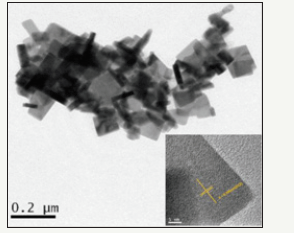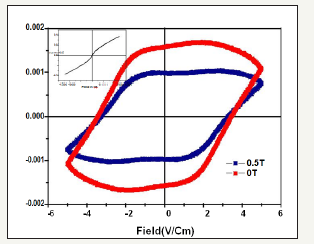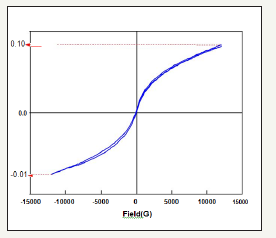- Submissions

Full Text
Research & Development in Material Science
Review of Multiferroicity in a Few Promising Nanoscale Systems
Aditi Sahoo1, Shubhankar Mishra1, Tania Chatterjee1, Sudipta Goswami1,2* and Dipten Bhattacharya1
1 Department of ENT, Calcutta national Medical College, India
2 Senior Research Associate, Indian Association for the Cultivation of Science, India
*Corresponding author:Sudipta Goswami, Department of ENT, Calcutta national Medical College, Senior Research Associate, Indian Association for the Cultivation of Science, India, Email: drsudiptagoswami@gmail.com
Submission: June 01, 2018;Published: August 14, 2018

ISSN: 2576-8840 Volume7 Issue4
Introduction
A new dimension of functionality emerges when magnetization is switched by electric field and vice versa within a single phase compound. Multiferroics-compounds that harness multi-ferro (ferroelastic, ferroelectric, ferromagnetic) orders-realize such advancements and, therefore, for justifiable reasons, have been occupying the centre-stage of research in the area of condensed matter. Numerous applications are possible: four logic-state memory (electrical writing and magnetic reading), ac/dc magnetic field sensors, microwave resonators, phase shifters, recording read heads, multiferroic generators to name a few. For obvious reasons, the compounds that exhibit strong magnetoelectric multiferroic coupling at room temperature itself are the most sought-after ones. The nanoscale systems exhibiting remarkably large magnetoelectric coupling at room temperature could usher a new regime of nanospintronic devices. Here in this brief review, we offer glimpses of new results from three promising nanoscale single-phase and composite systems which possibly turn out to be the game changer in this area in near future.
Nanoscale BiFeO3
BiFeO3 is the quintessential room temperature multiferroic which has attracted, by far, the maximum interest [1]. Magnetoelectric coupling in nanoscale BiFeO3 has been extensively investigated using isolated nanosized particles as well as epitaxial thin films [2]. We explored the size and shape effect. While size effect has been investigated by using spherical particles, shape effect demands synthesis of particles of different shapes. For example, nano-cubes have been prepared via hydrothermal method using metal nitrate precursor solution at optimum pH. The solution was autoclaved at 160 °C for 72h. The final product was thoroughly washed by distilled water and ethanol and dried at 80 °C in a vacuum drier. The TEM image (Figure 1) of as-prepared sample shows sheet-like structure consisting of nano-cubes of BiFeO3. Here, the individual nano-cube has an average length of 75-150nm with thickness 15-25nm. High resolution transmission electron microscopy, shown in inset of Figure 1, depicts that the [012] plane are mainly oriented perpendicular to electron beam direction. Room temperature magnetic hysteresis loop in the inset of Figure 2 shows a small ferromagnetic ordering. Multiferroic coupling of the nano cubes have been measured via measurement of remanent polarization hysteresis loop under zero and 0.5T magnetic field (Figure 2). For this purpose, the particles were deposited on an insulating Si/SiO2 substrate and Ag electrodes were deposited in two-probe configuration. It appears that a substantial change in the polarization occurs under the magnetic field confirming the presence of multiferroic coupling (~35%) in these BiFeO3 nano-cubes. The enhanced multiferroic coupling in BiFeO3 nanocubes compared to that in spherical particles of same size may be attributed to the influence of the shape anisotropy and thus open up new vistas of shape dependency or even quantum multiferroicity in proper one-dimensional systems.
Figure 1:TEM image of BiFeO3 nano-cubes; inset: HRTEM image of the nanoparticles.

Figure 2:Multiferroic coupling in BiFeO3 nano-cubes; inset: Magnetic M-H loop at room temperature.

BiFeO3-Graphene Composite
Figure 3:TEM image of Graphene-BiFeO3 nano-composite; inset: SEAD composite pattern of the nanocomposite.

Further enhancement of multiferroicity, e.g., enhancement in ferroelectric polarization, magnetic moment, and magnetoelectric coupling has been projected in the multiferroic-graphene composite systems. Recently, in a first principal calculation [3] it has been shown that there is a strong interaction between the graphene π electrons and the magnetic Mn d states of a magnetoelectric multiferroic BaMnO3 within BaMnO3-graphene composite which induces a significant spin polarization in graphene. It reveals a tremendous application potential of hybrid organic-multiferroic materials in spintronics devices and many other exotic phenomena in near future. Keeping in mind this possibility, a reduced graphene oxide and BiFeO3 (rGO/BFO) nano-composite has been prepared with an expectation of covalent bond formation between π congugate carbon network with either Bi or Fe ion (of BiFeO3) via any C or O groups. This, in turn, can enhance the magnetic properties. Initially, Graphene Oxide and BiFeO3 sol were prepared separately by Modified Hummer’s method and conventional sol gel method respectively. These two precursors were then mixed (2wt% GO) and autoclaved for 24h at 140 °C in a basic medium. The precipitate, thus obtained, was washed thoroughly and dried at 60 °C in vacuum. The laboratory X-Ray of the composite shows the presence of crystalline BiFeO3 phase mainly. Actually the BiFeO3 particles are embedded upon graphene oxide micro disrupted sheets with an average size of 6-10nm. This is also confirmed by the TEM image (Figure 3) which shows the presence of (110), (021) BiFeO3 plane in SAED pattern. Room temperature magnetic hysteresis loop (Figure 4) of the composite shows ferromagnetic behaviour and sizable enhancement in saturation magnetization.
Figure 4:TEM image of Graphene-BiFeO3 nano-composite; inset: SEAD composite pattern of the nanocomposite.

Nanoscale Double Perovskite System
Double perovskites materials have also drawn an extensive attention since last decades due to its multiferroic behavior and magnetoelectric coupling. Y2NiMnO6 being one of those double perovskite systems which possess giant dielectric tunability [4,5]. The dependence of the tunability on magnetic structure makes it a suitable candidate for a Type-II multiferroic. Single phase Y2NiMnO6 nanorods were prepared by hydrothermal method using Y(NO3)3.6H2O, Ni(NO3)3.6H2O and C4H6MnO4.4H2O in an autoclave at 180 °C for 24 hours in a basic medium. The precipitate thus obtained washed thoroughly and dried in vacuum at 80 °C for 4 hours followed by calcined at 1000 °C for another 4 hours. Transmission Electron Microscopy image (Figure 5) of the sample shows well defined Y2NiMnO6 nanorod with uniform diameter around 200nm. HRTEM image corresponds to (-111) plane with lattice spacing of 0.335nm has been shown in the inset Figure 5. Multiferroic coupling (Figure 6) of the sample were measured in the same manner as stated above and substantial change in the polarization (~59%) was observed indicating Y2NiMnO6 nanorod to be a giant magnetoelectric multiferroic at room temperature.
Figure 5:TEM image of Y2NiMnO6 nanotube; inset: HRTEM analysis of the nanotube.

Figure 6:Multiferroic coupling in Y2NiMnO6 nanotube.

Conclusion
Even though more detailed investigation and developmental work are needed in order to utilize the remarkable enhancement in magnetoelectric multiferroic properties of these systems for realization of real-life nanospintronic devices, yet the early results from nanoscale particles of different shapes for BiFeO3, grapheme- BiFeO3 composite, and nanoscale double perovskite Y2NiMnO6 appear to be extremely promising. In this sort review we present some highlights leaving the full details and future scope aside for a different and more comprehensive article. Nonetheless, in this brief article a taste of the fervour that is driving rigorous exploration both with conventional and newer compounds for ushering a new era of nanospintronics with multiferroics can be obtained.
References
- Catalan G, Scott JF (2009) Physics and applications of bismuth ferrite. Adv Mat 21(4): 2463-2485.
- Goswami S, Bhattacharya D (2016) Magnetoelectric multiferroicity at nanoscale. Sci Adv Today 2: 25227.
- Zanolli Z (2016) Graphene-multiferroic interfaces for spintronics applications. Sci Reports 6: 31346.
- Maiti RP, Dutta S, Mukherjee M, Mitra MK, Chakravorty D (2012) Magnetic and dielectric properties of sol-gel derived nanoparticles of double perovskite Y2NiMnO6. J App Phys 112: 044311.
- Su J, Yang ZZ, Lu XM, Zhang JT, Gu L, et al. (2015) Magnetism-driven ferroelectricity in double perovskite Y2NiMnO6. ACS Appl Mat Interface 7(24): 13260.
© 2018 Sudipta Goswami. This is an open access article distributed under the terms of the Creative Commons Attribution License , which permits unrestricted use, distribution, and build upon your work non-commercially.
 a Creative Commons Attribution 4.0 International License. Based on a work at www.crimsonpublishers.com.
Best viewed in
a Creative Commons Attribution 4.0 International License. Based on a work at www.crimsonpublishers.com.
Best viewed in 







.jpg)






























 Editorial Board Registrations
Editorial Board Registrations Submit your Article
Submit your Article Refer a Friend
Refer a Friend Advertise With Us
Advertise With Us
.jpg)






.jpg)














.bmp)
.jpg)
.png)
.jpg)










.jpg)






.png)

.png)



.png)






